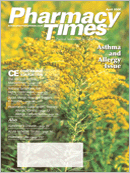Publication
Article
Pharmacy Times
A Pharmacist's Guide to OTC Therapy: Allergic Rhinitis
Author(s):
Approximately 36 million people in the United States suffer from allergic rhinitis. Whether it is seasonal or perennial, this condition can significantly impact an individual's quality of life. Fortunately, there are a number of medications available to treat the signs and symptoms associated with allergic rhinitis (Table 1). Selection of drug therapy is symptom-specific, and pharmacists can be instrumental in advising patients on the proper selection of the various nonprescription products currently on the market.
Triggers
Allergic rhinitis is triggered by aeroallergens, also referred to as airborne environmental allergens. Examples of common outdoor triggers include pollen and mold spores. Common indoor triggers include household dust mites, pet dander, and cigarette smoke.
Treatments
Although the best treatment for allergic rhinitis is to avoid exposure to allergens, doing so is not always a feasible means of therapy. The major goal for treating allergic rhinitis is to reduce or prevent the signs and symptoms associated with the ailment. Depending on the symptoms, products are available as single-entity formulations containing antihistamines (Table 2) or decongestants; as combination products containing both antihistamines and decongestants; and as combination products containing analgesics for treating headaches that may occur in some affected individuals (Table 3). Also available are a host of nasal drops and sprays, as well as ophthalmic drops, for the relief of allergy symptoms.
Antihistamines
Antihistamines are indicated for the relief of symptoms of allergic rhinitis such as itching, sneezing, and rhinorrhea. Systemic antihistamine products are available in various dosage forms, such as tablets and capsules (immediate- or sustained-release), chewable tablets, liquids, syrups, oral disintegrating tablets, and medicated thin strips.
Loratadine is the only nonsedating antihistamine available as an OTC agent. Loratadine does not have anticholinergic activity and penetrates poorly into the central nervous system, thus making it relatively free of sedating effects at usual doses.1
Decongestants
Because nasal congestion is a common symptom of allergic rhinitis, many individuals may require the use of decongestants. Due to the recent regulations concerning pseudoephedrine products, some manufacturers also have produced new alternative formulations of products that contain phenylephrine, such as Sudafed PE. In addition, a variety of decongestant sprays can be used to alleviate the symptoms of allergic rhinitis, but they should not be used for more than 3 to 5 days, since "rebound" congestion can occur.
Miscellaneous Products
Patients with allergic rhinitis also may benefit from the use of products such as cromolyn sodium (Nasalcrom) for relief. Therapy should be initiated prior to the start of the allergy season and should be used daily. Various homeopathic OTC products?including Cold-EEZE ZICAM Allergy Relief Liquid Nasal Gel, Boiron Sabadil Tablets, and Similasan Hay Fever Relief Nasal Spray?are available as well.
Role of the Pharmacist
Prior to recommending any products for allergic rhinitis, pharmacists should carefully assess the patient's allergy and medical history as well as medication profile to screen for possible drug-drug interactions and/ or contraindications. Pharmacists also can recommend nonpharmacologic measures for reducing allergies and encourage patients to seek medical advice from a physician if the condition does not seem to improve.
Ms. Terrie is a clinical pharmacy writer based in Haymarket, Va.
For a list of references, send a stamped, self-addressed envelope to: References Department, Attn. A. Stahl, Pharmacy Times, 241 Forsgate Drive, Jamesburg, NJ 08831; or send an e-mail request to: astahl@ascendmedia.com.







